Some of the information on this Web page has been provided by external sources. The Government of Canada is not responsible for the accuracy, reliability or currency of the information supplied by external sources. Users wishing to rely upon this information should consult directly with the source of the information. Content provided by external sources is not subject to official languages, privacy and accessibility requirements.
Any discrepancies in the text and image of the Claims and Abstract are due to differing posting times. Text of the Claims and Abstract are posted:
| (12) Patent: | (11) CA 2150817 |
|---|---|
| (54) English Title: | DEVICE FOR HOMOGENISING HIGHLY VISCOUS FLUIDS |
| (54) French Title: | DISPOSITIF D'HOMOGENEISATION DE FLUIDES TRES VISQUEUX |
| Status: | Deemed expired |
| (51) International Patent Classification (IPC): |
|
|---|---|
| (72) Inventors : |
|
| (73) Owners : |
|
| (71) Applicants : | |
| (74) Agent: | GOWLING WLG (CANADA) LLP |
| (74) Associate agent: | |
| (45) Issued: | 1997-07-01 |
| (86) PCT Filing Date: | 1994-09-30 |
| (87) Open to Public Inspection: | 1995-04-13 |
| Examination requested: | 1995-06-01 |
| Availability of licence: | N/A |
| (25) Language of filing: | English |
| Patent Cooperation Treaty (PCT): | Yes |
|---|---|
| (86) PCT Filing Number: | PCT/CH1994/000195 |
| (87) International Publication Number: | WO1995/009689 |
| (85) National Entry: | 1995-06-01 |
| (30) Application Priority Data: | ||||||
|---|---|---|---|---|---|---|
|
A device for homogenising highly viscous fluids has static mixing elements
(11, 12) and if required filtering elements (6). These elements of the device
are arranged in a sleeve (13) along the axis (15) of the sleeve. The sleeve is
made of several parts and the elements that make up the device are monolithic
components (10, 20; 60). Many or all components have flange- or nose-like
parts (4; 4a, 4b) with which they are anchored in the area of the sleeve
located between the parts that make up the sleeve and at the same time form
parts of the sleeve. This device is suitable for example as mixing head (1) in
the nozzle of an injection casting machine or as molten mass mixer in an
extruder.
Un dispositif d'homogénéisation de fluides très visqueux comprend des mélangeurs statiques (11, 12) et, le cas échéant, des éléments de filtrage (6). Ces éléments constitutifs du dispositif sont montés dans une douille (13) le long de l'axe (15) de la douille. La douille est constituée de plusieurs parties et les éléments constitutifs du dispositif forment des composants monolithiques (10, 20; 60). Plusieurs ou tous ces composants ont des parties (4; 4a, 4b) similaires à des rebords ou à des becs. Les composants sont ancrés dans la zone de la douille située entre les parties de la douille par ces parties similaires à des rebords ou à des becs et constituent en même temps des parties de la douille. Ce dispositif est utilisé par exemple comme tête mélangeuse (1) dans la filière d'une machine à couler par injection ou comme mélangeur de la masse fondue dans une extrudeuse.
Note: Claims are shown in the official language in which they were submitted.
Note: Descriptions are shown in the official language in which they were submitted.

For a clearer understanding of the status of the application/patent presented on this page, the site Disclaimer , as well as the definitions for Patent , Administrative Status , Maintenance Fee and Payment History should be consulted.
| Title | Date |
|---|---|
| Forecasted Issue Date | 1997-07-01 |
| (86) PCT Filing Date | 1994-09-30 |
| (87) PCT Publication Date | 1995-04-13 |
| (85) National Entry | 1995-06-01 |
| Examination Requested | 1995-06-01 |
| (45) Issued | 1997-07-01 |
| Deemed Expired | 2013-10-01 |
There is no abandonment history.
| Fee Type | Anniversary Year | Due Date | Amount Paid | Paid Date |
|---|---|---|---|---|
| Application Fee | $0.00 | 1995-06-01 | ||
| Registration of a document - section 124 | $0.00 | 1996-01-04 | ||
| Maintenance Fee - Application - New Act | 2 | 1996-09-30 | $100.00 | 1996-08-20 |
| Maintenance Fee - Patent - New Act | 3 | 1997-09-30 | $100.00 | 1997-08-18 |
| Maintenance Fee - Patent - New Act | 4 | 1998-09-30 | $100.00 | 1998-08-24 |
| Maintenance Fee - Patent - New Act | 5 | 1999-09-30 | $150.00 | 1999-08-13 |
| Maintenance Fee - Patent - New Act | 6 | 2000-10-02 | $150.00 | 2000-08-14 |
| Maintenance Fee - Patent - New Act | 7 | 2001-10-01 | $150.00 | 2001-08-17 |
| Maintenance Fee - Patent - New Act | 8 | 2002-09-30 | $150.00 | 2002-08-15 |
| Maintenance Fee - Patent - New Act | 9 | 2003-09-30 | $150.00 | 2003-08-19 |
| Maintenance Fee - Patent - New Act | 10 | 2004-09-30 | $250.00 | 2004-08-23 |
| Maintenance Fee - Patent - New Act | 11 | 2005-09-30 | $250.00 | 2005-08-25 |
| Maintenance Fee - Patent - New Act | 12 | 2006-10-02 | $250.00 | 2006-08-24 |
| Maintenance Fee - Patent - New Act | 13 | 2007-10-01 | $250.00 | 2007-08-23 |
| Maintenance Fee - Patent - New Act | 14 | 2008-09-30 | $250.00 | 2008-08-25 |
| Maintenance Fee - Patent - New Act | 15 | 2009-09-30 | $450.00 | 2009-09-17 |
| Maintenance Fee - Patent - New Act | 16 | 2010-09-30 | $450.00 | 2010-09-16 |
| Maintenance Fee - Patent - New Act | 17 | 2011-09-30 | $450.00 | 2011-09-16 |
Note: Records showing the ownership history in alphabetical order.
| Current Owners on Record |
|---|
| SULZER CHEMTECH AG |
| Past Owners on Record |
|---|
| SIGNER, ARNO |